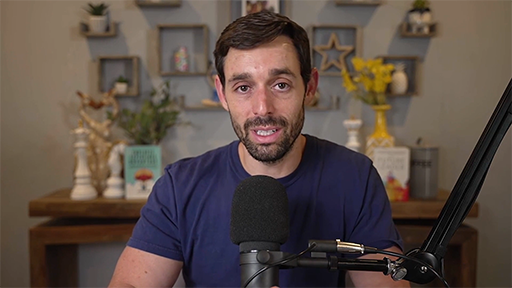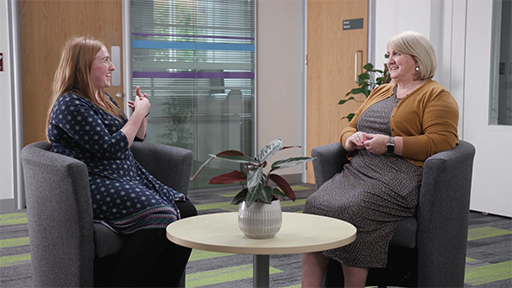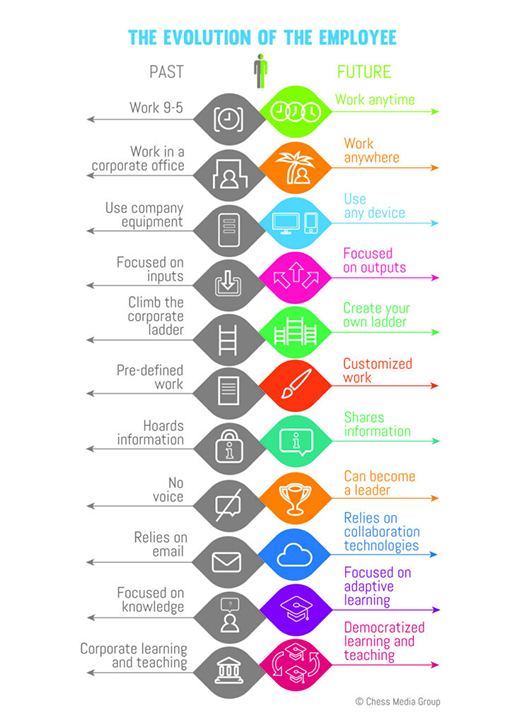4.3 The evolution of the employee
When people are put first, and a human-centred approach is taken, organisations need to consider what this will mean in reality, given the environment the organisation operates – what is possible? When there is finite resource, budget and limitations on infrastructure.
By understanding the evolution of the employee, organisations can start to design how they will work by considering the implications and how they can manage expectations and needs between organisations, teams and individuals.
Jacob Morgan’s info graphic succinctly visualises how the employee’s relationship to work has evolved.
In the video below, Jacob Morgan explains the evolution of the employee, and what this might mean for organisations.

Transcript
The evolution of the employee must be considered alongside the Hybrid Ways of Working: A Contextual Framework because the elements within it will have an impact on your decisions as a leader, for example around cyber security. Hybrid working can mean organisations have less control over how, where and what devices employees use, which means that good online security policies and procedures for both employees and contractors are essential.
Now and the future
The evolution of the employee diagram above clearly shows the shift in expectations; some are already a reality, and understanding them will help you plan better for the future.
Work anytime: Employees set how they work their contracted hours around the needs of the outputs they need to deliver and the teams they are working with. This is especially important for those working on international projects, working across time zones, or those who welcome the flexibility to fit around their family commitments or have found that early mornings or late nights are when they perform best, with fewer distractions.
Work anywhere: Where does someone need to be to work? The pandemic has brought to the forefront that people can and will work anywhere if needed, for example those who regularly travel for business will frequently sit in cafés, airports, hotels to work. Online security and secure Wi-Fi access becomes essential in these situations.
Use any device: As an organisation you need to consider what devices your employees – and contractors – are using. People are using multiple devices as technology makes it easier to access work systems from smartphones and tablets, not just desktop computers or employer-issued laptops.
Focused on outputs: Trusting employees to deliver their outputs rather than ‘presenteeism’ allows flexible working and gives employees ownership over their work. Managing this can be challenging: leaders need to be able to monitor not only whether those outputs are delivered, but also whether employees are managing their workload effectively – both in terms of too little and too much – which can be hidden when working in hybrid teams.
Create your own ladder: Depending on the environment in which you operate, not all careers have a formal path of starting at the bottom of the ladder and working your way up. For many there is no fixed route, especially where the job they might go into doesn’t exist today or hasn’t even been imagined. People move in all directions within their careers, often completely changing their vocation and lifestyle choices.
Customised work: Many employees who can do so are managing their own careers and choosing to work for organisations or on projects either as employees or on contracts that fit with their lifestyles and career interests. Often the decisions are not about the career ladder, but their own motivations and values.
Can become a leader: The voice of the employee has become more valuable, especially as we come out of the pandemic, to understand their needs and share their ideas, thoughts and concepts that can help organisations develop. Access to people through collaboration platforms is enabling people to lead especially on projects, but also to lead others both formally and informally. A leader is not now seen as someone who has just been given that title, but through the actions they display to bring others together and take them on a journey.
Knowledge vs adaptive learning: The ability to find ‘knowledge’ via an internet search means most people can find an answer with ease. What becomes more important is an employee’s critical thinking skills to interpret that knowledge, and learn new things to adapt, understand interdependencies and apply the learnings to new situations and scenarios.
Everyone’s a teacher or a student: While formal education and organisational learning is still required, encouraging informal learning allows employees to quickly learn from each other, connect and build networks. Access to ‘learning’ through online platforms and networks such as OpenLearn, FutureLearn, Coursera, LinkedIn Learning, TikTok and YouTube has made it more accessible, cheaper and faster.
Source: adapted from The evolution of the employee [Tip: hold Ctrl and click a link to open it in a new tab. (Hide tip)]
Activity 12: What makes a good employee and student experience?
Think about the expectations of ‘evolving employees’ and students, and what Josh Morgan believes organisations need to be focusing on for a good employee experience. Listen to Alayla Castle-Herbert, Policy Officer (Learning & Teaching) talking to Louise Casella, Director – The Open University in Wales about their experience of starting a new role.

Transcript
What might this mean for your organisation, what policies and procedures might be required?
How flexible can you be as an organisation, both for employees and for students?
How can you ensure the best experience for those within your organisation?
Comment
Much of the focus of this model appears to be based on those workers who have some control over their work, but what does this mean for those who need to be onsite and have ‘prescriptive’ tasks – for example ‘on site catering roles’.
What could be the challenges if an organisation focuses on those who can work more flexibly, while not considering the impact of those in ‘constrained’ roles?
As ways of working change, it is important to consider all the stakeholders in an organisation, and what you are required to by law to consider/adhere to. While in some areas employees can work more flexibility, others either due to their ‘job’ or their individual needs cannot. It is essential to consider equity, diversity, inclusion and accessibility when developing your organisation.
To explore this further, the following articles from McKinsey provide further insights into employee’s needs.
Three types of modern flexibility today’s workers demand | McKinsey & Company
This time it’s personal: Shaping the ‘new possible’ through employee experience | McKinsey

